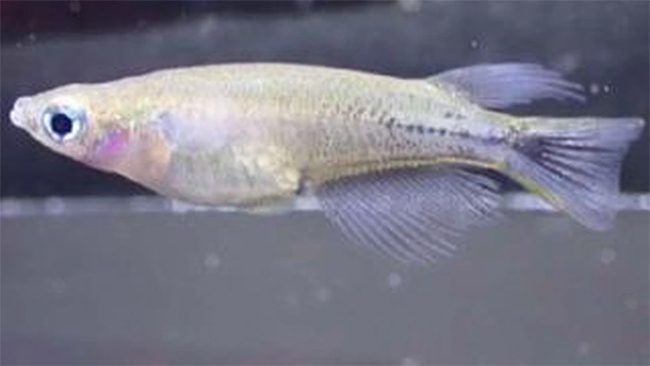Scientists have discovered a small, aggressive fish species from Indonesia that can change its entire body color to black when angry to assert its dominance.
Researchers found that the powerful males of a fish species known as Celebes Medaka can turn black when they enter a highly aggressive state. When conflict arises, the fish’s body changes to black within one minute.
This seems to be a display of power towards other fish species. These fish are fierce and aggressive, which means they are less likely to be attacked.

A male rainbowfish starts to show black spots on its body. (Photo: Ueda et al.)
To investigate the environmental conditions that trigger their agitation and color change, researchers conducted experiments in three fish tanks. Two of the tanks were filled with algae: one contained two males and one female, while the other held three males. The third tank had no algae and contained two males and one female.
In the two algae-filled tanks, the males fought, whereas in the tank without algae, they did not. This indicates that when there is some form of cover (the algae-filled tank), they feel secure enough to prepare to attack their rivals.
The color-changing males focused their attacks on other males with similar black markings and also targeted females and non-color-changing males. Although non-color-changing males rarely attacked color-changing males, they did attack females and non-color-changing males.
The females primarily fought with non-black-marked males. Meanwhile, the black-marked males frequently attacked females. The aggression towards females suggests a connection to territorial and resource acquisition rather than mating rights.
Other fish species also exhibit similar changes in body color through the activity of neurotransmitters on cells containing pigment granules. When pigments concentrate in the cells, the color becomes darker, and vice versa. For instance, Trinidadian guppies also change their eye color to black when preparing to attack their rivals.
In the case of the Celebes Medaka, these cells may be melanophores, which contain dark melanosome pigment granules.
Biologist Robert Heathcote from the University of Oxford in the UK noted that adrenaline can stimulate melanophores, but it does not always cause the dominant individuals to turn darker. In fact, many fish exhibit the opposite phenomenon, where the weaker individuals that are bullied turn darker, especially when they have hiding spots. This may relate to camouflage to avoid being attacked.
During such moments, the speed at which fish change color can vary based on many factors, but perhaps the most important factor is the control when nerves are directly stimulated or due to the levels of new pigment production. In fish and cephalopods, color changes can occur in just a few seconds.


















































